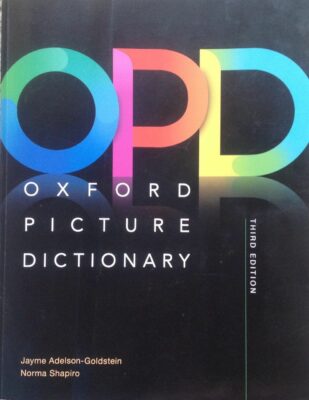This article explains the benefits of the Amazon Oxford Dictionary, its usefulness for every ESL student, and how I use it in my adult education classes.
I recommend it for anyone who is learning English, whether a beginner, intermediate, or advanced learner. After all, a picture is said to be worth 1000 words. Assuming that’s the case, this book is a potential spawning ground for millions of words.

I swear by it.
Perhaps, after reading what follows, you will too.
Who Puts Out The Publication?
Let me be perfectly clear. Amazon did not author or publish it. It is available for purchase at Amazon. Perhaps it’s available elsewhere as well.
Although there are several versions and editions, in this article, I will focus on the third edition.
However, I recommend all versions and editions. They are all excellent!
The authors are Jayme Adelson-Goldstein and Norma Shapiro. However, there a multitude of contributors.
It is published by Oxford University Press.
 Why Do I Recommend It?
Why Do I Recommend It?
Shakespeare said:
“A rose by any other name would smell as sweet.”
The same principle is true for most anything you can think of. The problem is, if you don’t know what a rose is, Shakespeare’s quote makes no sense.
As an English as a second language (ESL) teacher, my students speak a variety of languages other than English. My guess is, most, if not all of them know what a rose is, but they know it by another name that is native to their language, although sometimes it’s the same or similar.
For example, in Spanish, the word for rose is rosa.
In this picture dictionary on page 217, the page about flowers, the 15th picture is of a rose.
No matter what it’s called in another language, a picture and the word associated with it makes it possible for people to learn the English translation.
Furthermore, when teaching and/or learning a new language, it’s not always about only learning new words. Learning new phrases and concepts are also major elements of the teaching and learning process.
For example, what if we’re talking about the concept of meeting and greeting? There are many words associated with this concept. What’s the best way to convey the concept and the words associated with it.
It’s possible that demonstrating the words will be effective. I do demonstrate and I have the class demonstrate to the others in the class and me that they understand.
On pages 2 & 3 of this picture dictionary are two full pages in color of a classroom full of adult students, many of who are sitting in desks, while others are standing, or moving about in the classroom. It shows the teacher entering the room.

There are thirteen (13) words and phrases on this page.
- Say, “Hello”
- Ask, “How are you?”
- Respond, “Fine, thanks.”
- Introduce yourself
- Smile
- Hug
- Wave
- Greet people
- Bow
- Introduce a friend
- Shake hands
- Kiss
- Say, “Goodbye.”
I doubt anyone in the class does not understand each of these words, phrases, and concepts in his/her native language. Some may know some of them in English already but, the chances are, few, if any of them know all of them in English.
So, that’s only the beginning. There are 247 pages like the example I just mentioned. There are another 39 pages of information that supports those 247 pages. There are 287 pages in all.
How Do I Use It?
I definitely begin each new term/semester/trimester or whatever the case may be where the class is full of people who don’t know one another.
We use pages 2 & 3 and the exact same thirteen terms mentioned above

It’s the best ice-breaker I know of to get people engaged, up out of their seats, getting to know one another.
I’m always amazed how before class begins and for the first few minutes after class begins, you can hear a pin drop. Everyone except me is completely silent. You’d think we’re at a funeral.
However, by the end of the class, after they have all participated in learning and practicing with each other and me what they learned on those two pages, the class is full of budding friendships.
When administrators enter my class to see how many new students there are etc.,they are amazed at the level of energy being exuded in my class on the first day.
It’s awesome!
On the first day of class, it usually takes 45-60 minutes to complete the tasks.
From there, I ask them to try to write 1-3 complete sentences in English about what they’ve learned. I allow them to use a translator. We primarily use Google Translate in my class.

This allows me to learn what level a student’s level of writing and understanding is. Some students are either afraid to write or simply can’t, but surprisingly, most at least try and most of the writings are full of mistakes. Whatever the case may be, I now have something to work with as far as where to go from there.
One thing is for sure, most days, we begin class using one of the other pages in the picture dictionary as a warm up for what we will be covering that day.
We first go over the terms and they translate the English to their own language. Then they write. Then, as a class, we review and make corrections to their writing.
What they don’t realize is, they are actually teaching themselves as much, if not more than I can teach them and are learning more than they realize.
Maybe you’re beginning to see the value.
What Are the By Products?
As I stated above, I use the picture dictionary as a warm up for what we will be covering that day.
Before we even begin the actual lesson, they already have an idea about it, whether or not they realize it. By the time we get into the lesson, they may have already written a little bit about the subject.
I find this particularly valuable when the topic of the lesson is about grammar and verb tenses.
During the warm-up, we not only cover the translations of the words, but I am able to ask them questions, especially when it comes to verbs.
For example, on pages 6 & 7 of the picture dictionary are pages about a classroom, complete with 41 words and terms pertinent and relevant to a classroom. Of course all of them have a corresponding picture.

One of the terms that correponds to a picture is “raise your hand.” The picture is of a man raising his hand.
Everyone knows what that means and how to do it, but they most likely do not know how to say it in English.
In addition to the simple translation, I have a verb to work with and a personal pronoun.
I can ask what is he doing? Many of them will answer, “raise your hand”. That gives me the opportunity to explain to them that he is not raising my hand or your hand. He is raising his hand.
If we are talking about past tenses, I can ask what did he do.
I can ask who is raising his hand. Many of them will point to the picture. They know what I’m asking but don’t know how or are afraid to say, “he is raising his hand.” or “the man is raising his hand.”
These are but a few of the examples. There are countless others.
I dare say that an entire three-hour class period, which is how long my classes are, can be completed using nothing other than this picture dictionary.
Taking it even further, an entire semester/trimester/term could also be completed using nothing more than this picture dictionary.
Conclusion
I hope I have provided a look inside of this fruitful publication with my descriptions and examples. Because of copywrite laws etc. I am not able to provide actual pictures from the publication.
You’ll need to purchase a copy of your own for that. You can purchase the Amazon Oxford Picture Dictionary here.
I can think of no better tool to support learning English than this publication.

Buy now–ISBN 978-0-19-450529-1
Leave comments and questions below and I will promptly respond.

I understand that learning English as a second language is very difficult. The developers of this book to support those learning English went to great lengths to ensure that the information in the book was complete and easily understood. Using visuals that demonstrates the words – actions and tenses – make learning the language far easier. This site describes the books use in ESL classes and I believe it should be part of every lesson. I wonder if there are similar books for other languages.
Deedee
Thanks for your comments Deedee. I don’t know for sure but I believe there are similar books for several other languages.
Feel free to leave comments and questions any time. I will promptly respond.
KBob